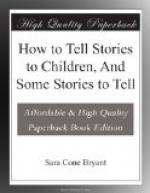When the cow had eaten the hay, she gave the old woman the milk; and away she went with it in a saucer to the cat.
As soon as it had lapped up the milk, the cat began to kill the rat; the rat began to gnaw the rope; the rope began to hang the butcher; the butcher began to kill the ox; the ox began to drink the water; the water began to quench the fire; the fire began to burn the stick; the stick began to beat the dog; the dog began to bite the pig; the little pig in a fright jumped over the stile; and so the old woman did get home that night.
* * * * *
The briefest examination of these three stories reveals the fact that one attribute is beyond dispute in each. Something happens, all the time. Every step in each story is an event. There is no time spent in explanation, description, or telling how people felt; the stories tell what people did, and what they said. And the events are the links of a sequence of the closest kind; in point of time and of cause they follow as immediately as it is possible for events to follow. There are no gaps, and no complications of plot requiring a return on the road.
A second common characteristic appears on briefest examination. As you run over the little stories you will see that each event presents a distinct picture to the imagination, and that these pictures are made out of very simple elements. The elements are either familiar to the child or analogous to familiar ones. Each object and happening is very like everyday, yet touched with a subtle difference, rich in mystery. For example, the details of the pictures in the Goldilocks story are parts of everyday life,—house, chairs, beds, and so on; but they are the house, chairs, and beds of three bears; that is the touch of marvel which transforms the scene. The old woman who owned the obstinate pig is the centre of a circle in which stand only familiar images,—stick, fire, water, cow, and the rest; but the wonder enters with the fact that these usually inanimate or dumb objects of nature enter so humanly into the contest of wills. So it is, also, with the doings of the three little pigs. Every image is explicable to the youngest hearer, while none suggests actual familiarity, because the actors are not children, but pigs. Simplicity, with mystery, is the keynote of all the pictures, and these are clear and distinct.
Still a third characteristic common to the stories quoted is a certain amount of repetition. It is more definite, and of what has been called the “cumulative” kind, in the story of the old woman; but in all it is a distinctive feature.
Here we have, then, three marked characteristics common to three stories almost invariably loved by children,—action, in close sequence; familiar images, tinged with mystery; some degree of repetition.




